See for yourself why people have been awed by this magnificent structure for centuries!
Legend has it that while the Cathedral of Seville was being built, the church elders said, “Let us build a church so beautiful and so grand that those who see it finished will think we are mad.”
And trust us, the minute you set eyes on it, you’ll have trouble picking your chin up off the floor! It’s the third-largest cathedral in the world, and the largest Gothic one, but these aren’t the only things that make truly unique—the history you find within its walls is what will keep you wanting to know more.
Read on for everything you need to know (and can’t miss!), for your visit to the Seville Cathedral!
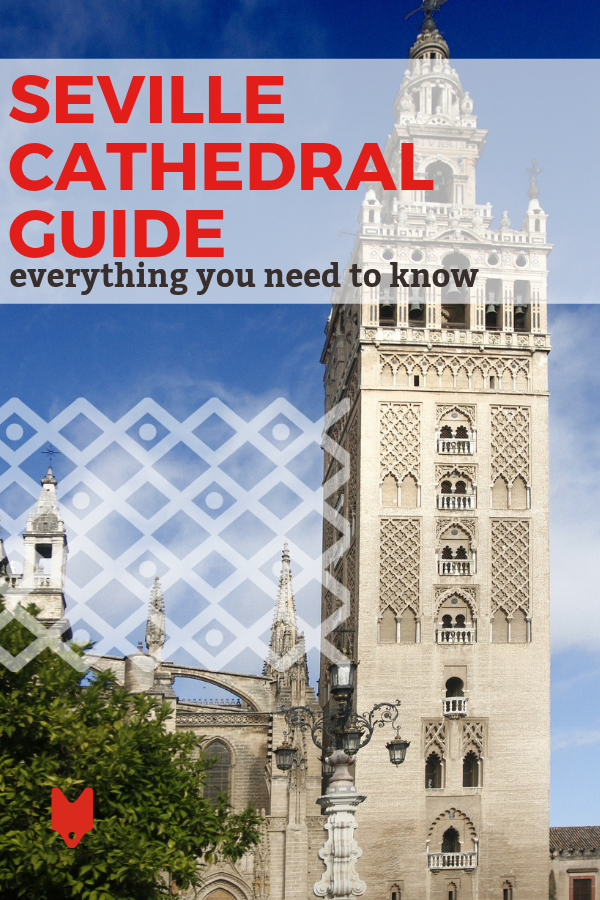
A brief history
As you will find with many famous buildings in Andalusia, the cathedral has its origins with the Moors.
The cathedral’s bell tower, the Giralda, in fact, is the old minaret that called Muslims in Seville to prayer five times a day. You may find it strange that the Catholics held on to parts leftover from the Moorish reign, but this is quite typical throughout the history of Andalusia.
Until Ferdinand III conquered the city in 1248, the space where the cathedral lays was the site of the Almohad mosque, as it had been for nearly a century. As the city became one of the Catholic kingdom’s predominant ports, those in charge wanted to build the largest cathedral in the world to prove their wealth and importance to outsiders. In 1402 construction for the lavish cathedral began, and wouldn’t finish until over a century later, in 1506.
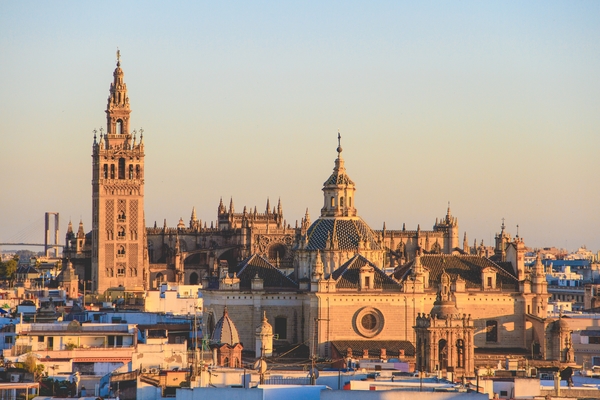
Our trick for tickets without the line
The cathedral and Giralda are without a doubt two of the most sought-after sights in Seville, and not planning ahead could mean hours spent sizzling under the sun while waiting in line. The good news is that there’s a great way to beat the line and see another gorgeous church at the same time.
How to do it? Visit Seville’s second-largest church, the Church of El Salvador, first. Buy the combined ticket that also allows entrance to the cathedral, enjoy your visit of El Salvador, and then skip the line at the cathedral of those waiting to purchase a ticket, since you’ve already got yours!
Find our complete guide to beating the lines in Seville here.
You can also plan ahead by simply purchasing tickets online if you know the day and time you would like to visit.
If it’s your second time in Seville or you’re looking for a different way to see the cathedral and the city at the same time, try a cathedral rooftop tour!
Hours:
- Mondays: 11 a.m.–3:30 p.m.
- Tuesdays–Saturdays: 11 a.m.–5:00 p.m.
- Sundays: 2:30 p.m.–6 p.m.
Price:
- €9 general admission
- €4 for retirees and students under the age of 25. Don’t forget your ID!
- Free for residents of Seville or those who were born here, disabled people with an escort, and children up to age 14 with an adult. Be sure to bring identification!
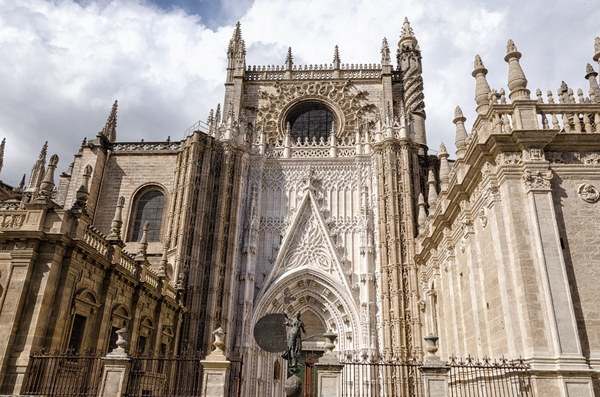
What you can’t miss inside
If you want to truly experience the cathedral and everything it holds within its walls, it’s not something you should leave for the last hour of your trip. Even if you aren’t a history fanatic, it will take at least a few hours to completely explore. After all, it has a total area of 124,000 square feet and 80 chapels inside. Read on for everything you should be sure to see!
The Giralda
The crown jewel of the cathedral and the undisputed emblem of Seville itself, you cannot leave without traipsing up its 35 ramps (easier than stairs!) to get to the top for unparalleled views of the city.
Take your time and don’t rush up—there’s plenty of space to stop and allow others to keep moving. In fact, the space is large enough for someone to climb up on horseback. Why? Because when the tower was a minaret, climbing five times a day for the call to prayer was much easier with a horse carrying you!
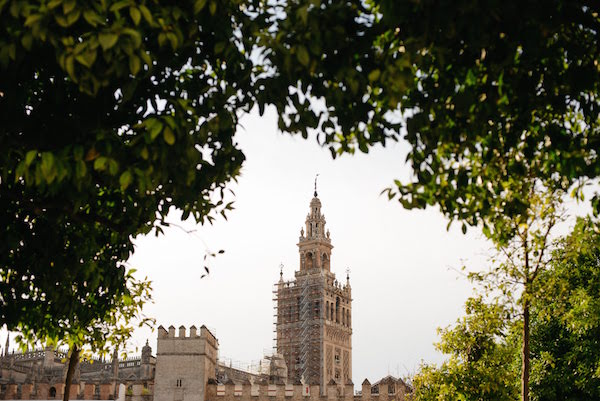
Christopher Columbus’ Tomb
One of the last additions to the cathedral and a hot topic for debate are the remains of Christopher Columbus.
He is in a coffin being carried by four figures which represent the kingdoms of Spain during his lifetime: Navarre, Aragon, Castile and Leon.
His remains went on quite the journey after he died, traveling from Valladolid to the Dominican Republic to Cuba and back to Seville again, which they have called their resting place since 1898—although the Dominican Republic insists he never left.
So is he really in Seville? You’ll have to decide for yourself!
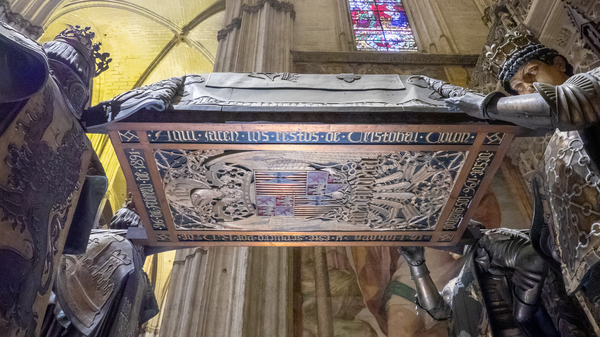
The Great Chapel and Altarpiece
The main chapel, home to the largest altarpiece in the world, is the Great Chapel. You can find it opposite the choir, where the two naves meet. The altarpiece is made up of 44 reliefs from scenes in the Bible made in polychrome wood and copious amounts of gold. Built by numerous artists and sculptors, it took nearly a century to complete.
Royal Chapel
Just behind the Great Chapel lies one of the only visible examples of Renaissance architecture in the cathedral: the Royal Chapel.
It was constructed between 1551 and 1575 to harbor remains of Spanish royalty of the time. On one of the altars you can find a silver shrine with relics of St. Ferdinand and on the other stands the Virgin of the Kings, the patron saint of the city.
Fun fact: the crown sitting on top of the virgin’s head has nearly 12,000 precious stones and is made of 22-karat gold. Royal indeed!
The Orange Tree Courtyard
One of our favorite parts of the cathedral is the patio de los naranjos, or the orange tree courtyard. As its name suggests, it’s full of these fragrant trees and is an idyllic place to rest and contemplate your visit before you leave.
It’s easy to connect its architecture and design to its Moorish origins as a place for prayer in the mosque that once occupied this space. The fountain in the center is one of the only remnants of the Visigoth period and sits atop the original fountain that was used by Muslims for their washing ritual before entering the mosque.
Beware! They may smell sweet and look delightful but these oranges are not for snacking! Oranges all over Seville are used to make famous Seville orange marmalade—but with plenty of sugar added to combat their naturally bitter taste.

The Door of Forgiveness
This door is another curiosity of the cathedral and a nod to its Islamic origins. Although now it’s the door you’ll exit from after touring the cathedral, it was originally the entrance to the mosque—the intricate carvings around it will give that away.
On either side we can find the Catholic elements of St. Peter, St. Paul, the Archangel Gabriel, and the Virgin Annunciate which were added after the Catholics took control of the city—their way of making it known to whom the door now belongs. However, its origins pervade, as even in the iron door we can find inscriptions from the Quran such as “power belongs to Allah.”
Where to eat afterwards
Once you finish your tour of the cathedral, there’s a good chance you are going to be in need of a couple tapas and an ice-cold cerveza. Don’t worry, we’ve got you covered. Here are some of our favorite places to eat near the cathedral. Go on, you’ve earned it!